1996 CHEVROLET MONTE CARLO air condition
[x] Cancel search: air conditionPage 273 of 340
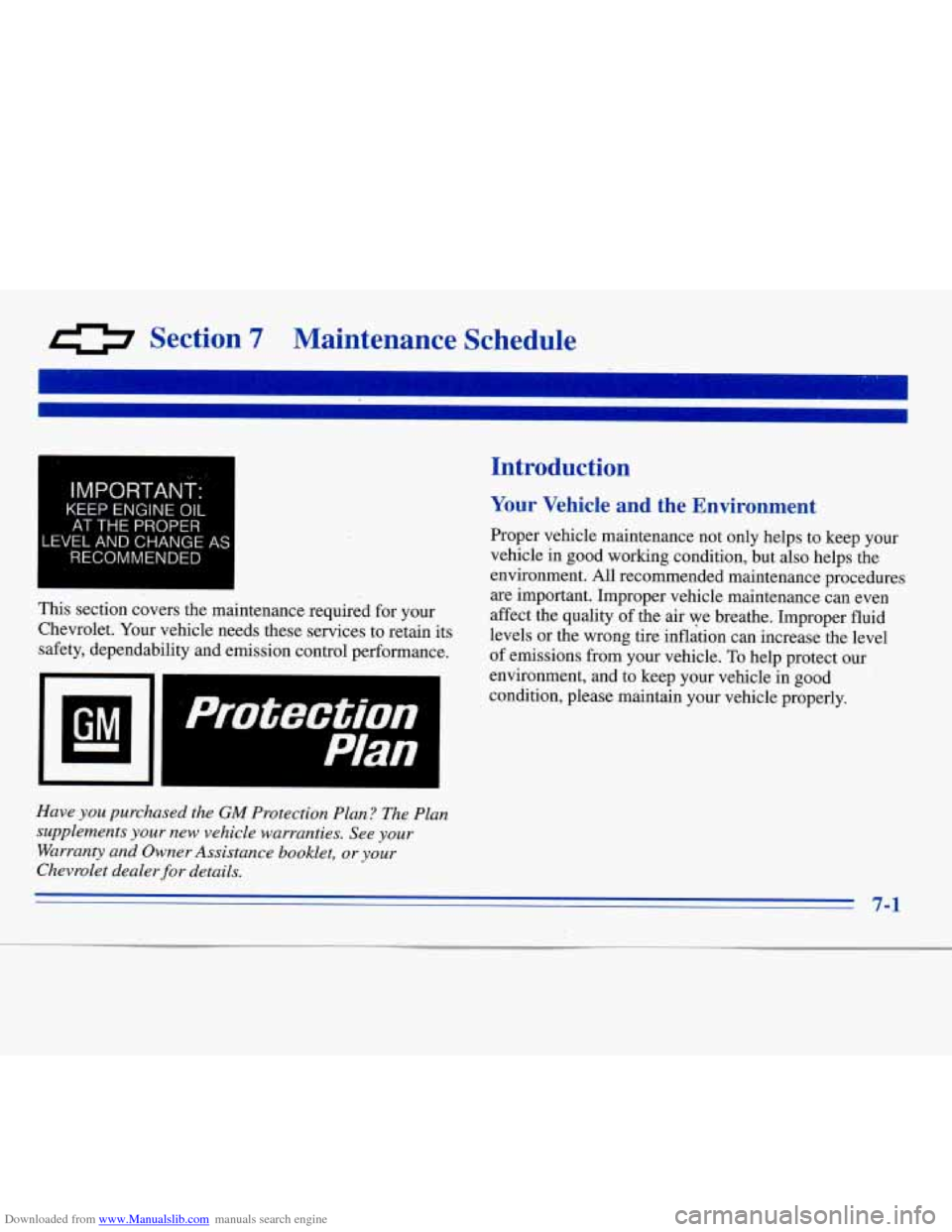
Downloaded from www.Manualslib.com manuals search engine 0 Section 7 Maintenance Schedule
IMPORTANT:"
KEEP ENGINE OIL
AT THE
PROPER
-EVEL AND CHANGE AS
RECOMMENDED
I
Introduction
Your Vehicle and the Environment
Proper vehicle maintenance not only h,elps to keep your
vehicle in good working condition, but also helps the
environment.
All recommended maintenance procedures
are important. Improper vehicle maintenance can even
This section covers the maintenance required for your affect
the quality of the air we breathe. Improper fluid
Chevrolet. Your vehicle needs these services to retain its
levels or the wrong tire inflation can increase the level
safety, dependability and emission control performance.
of emissions from your vehicle. TO help protect our
environment, and to keep your vehicle in good
condition, please maintain your vehicle properly.
protection Plan I
Have you purchased the GM Protection Plan ? The Plan
supplements
your new vehicle warranties. See your
Warranty and Owner Assistance booklet, or your
Chevrolet dealer for details.
7-1
Page 275 of 340

Downloaded from www.Manualslib.com manuals search engine Part A: Scheduled Maintenance
Services
Using Your Maintenance Schedule
We at General Motors want to help you keep your
vehicle
in good working condition. But we don’t know
exactly how you’ll drive
it. You may drive very short
distances only
a few times a week. Or you may drive
long distances all the time in very hot, dusty weather.
You may use your vehicle in making deliveries.
Or
you may drive it to work, to do errands or in many
other ways.
Because of all the different ways people use their GM
vehicles, maintenance needs vary.
You may even need
more frequent checks and replacements than you’ll find
in the schedules in this section. So please read this
section and note how you drive.
If you have any
questions
on how to keep your vehicle in good
condition, see your Chevrolet dealer.
This part tells you the maintenance services you should
have done and when you should schedule them. If you
go to your dealer for your service needs, you’ll know
that GM-trained and supported service people will
perform the work using genuine GM parts. The
proper fluids and lubricants to use are listed
in Part D.
Make sure whoever services your vehicle uses these. All
parts should be replaced and all necessaly repairs done
before you or anyone else drives
the vehicle.
These schedules are for vehicles that:
carry passengers and cargo within recommended
limits. You will find these limits on
your vehicle’s
Tire-Loading Information label. See “Loading
Your Vehicle”
in the Index.
are driven on reasonable road surfaces within legal
driving limits.
use the recommended fuel. See “Fuel” in the Index.
Selecting the Right Schedule
First you’ll need to decide which of the two schedules is
right for your vehicle. Here’s how to decide which
schedule to follow:
7-3
Page 276 of 340
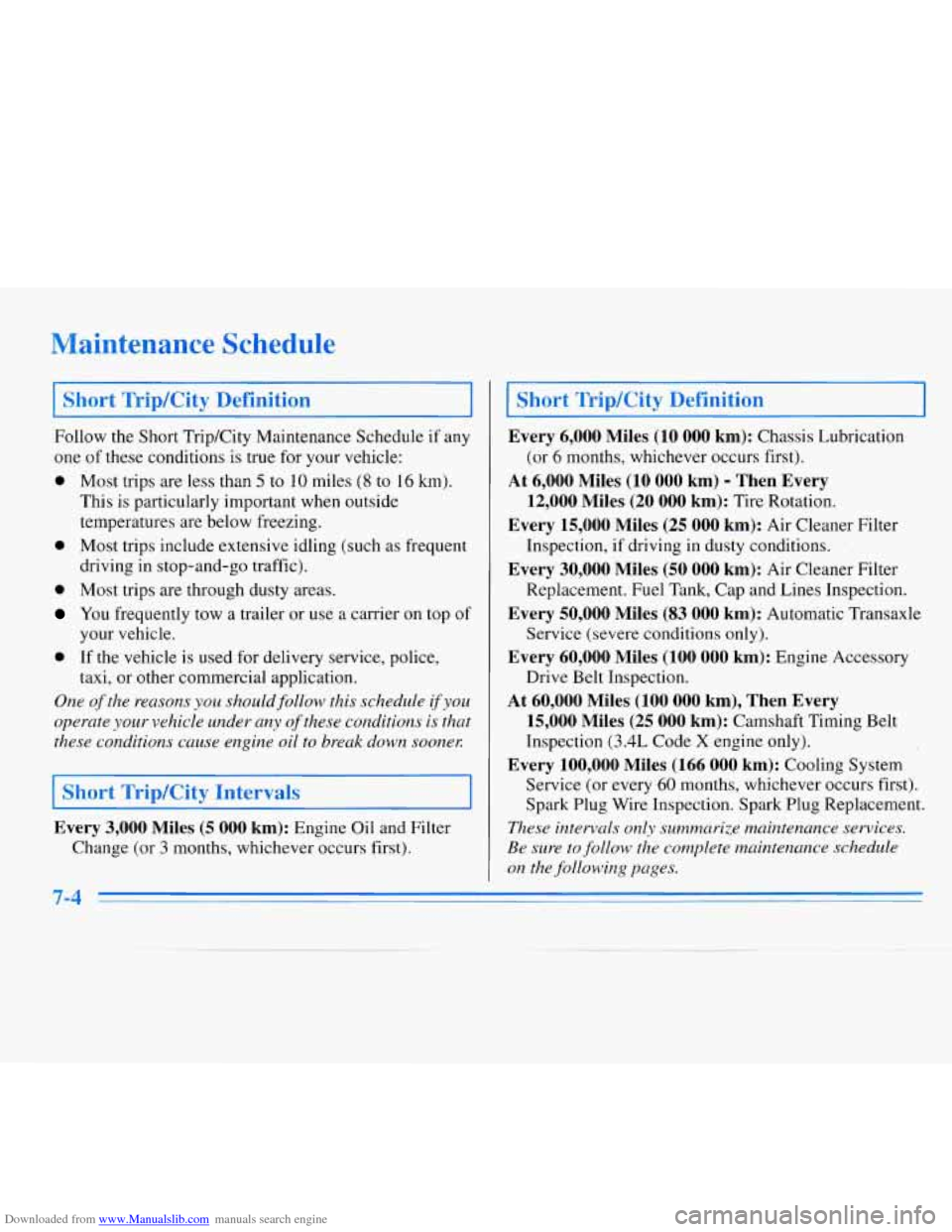
Downloaded from www.Manualslib.com manuals search engine Maintenance Schedule
I Short Trip/City Definition
Follow the Short TripKity Maintenance Schedule if any
one of these conditions is true for your vehicle:
0 Most trips are less than 5 to 10 miles (8 to 16 km).
This is particularly important when outside
temperatures are below freezing.
0 Most trips include extensive idling (such as frequent
driving in stop-and-go traffic).
0 Most trips are through dusty areas.
You frequently tow a trailer or use a carrier on top of
0 If the vehicle is used for delivery service, police,
One of the reasons you shouldjollow this schedule ifyou
operate your vehicle under any of these conditions is that
these conditions cause engine oil to break down sooney:
your vehicle.
taxi, or other commercial application.
I Short Trip/City Intervals I
Every 3,000 Miles (5 000 km): Engine Oil and Filter
Change (or
3 months, whichever occurs first).
Short Trip/City Definition
Every 6,000 Miles (10 000 km): Chassis Lubrication
(or
6 months, whichever occurs first).
At 6,000 Miles (10 000 km) - Then Every
12,000 Miles (20 000 km): Tire Rotation.
Every 15,000 Miles (25 000 km): Air Cleaner Filter
Inspection, if driving in dusty conditions.
Every 30,000 Miles (50 000 km): Air Cleaner Filter
Replacement.
Fuel Tank, Cap and Lines Inspection.
Every 50,000 Miles (83 000 km): Automatic Transaxle
Service (severe conditions only).
Every 60,000 Miles (100 000 km): Engine Accessory
Drive Belt Inspection.
At 60,000 Miles (100 000 km), Then Every
15,000 Miles (25 000 km): Camshaft Timing Belt
Inspection
(3.4L Code X engine only).
Every 100,000 Miles (166 000 km): Cooling System
Service (or every
60 months, whichever occurs first).
Spark Plug Wire Inspection. Spark Plug Replacement.
These intervnls only summarize maintenance services.
Be sure to follow the complete maintenance schedule
on the following pages.
7-4
Page 277 of 340
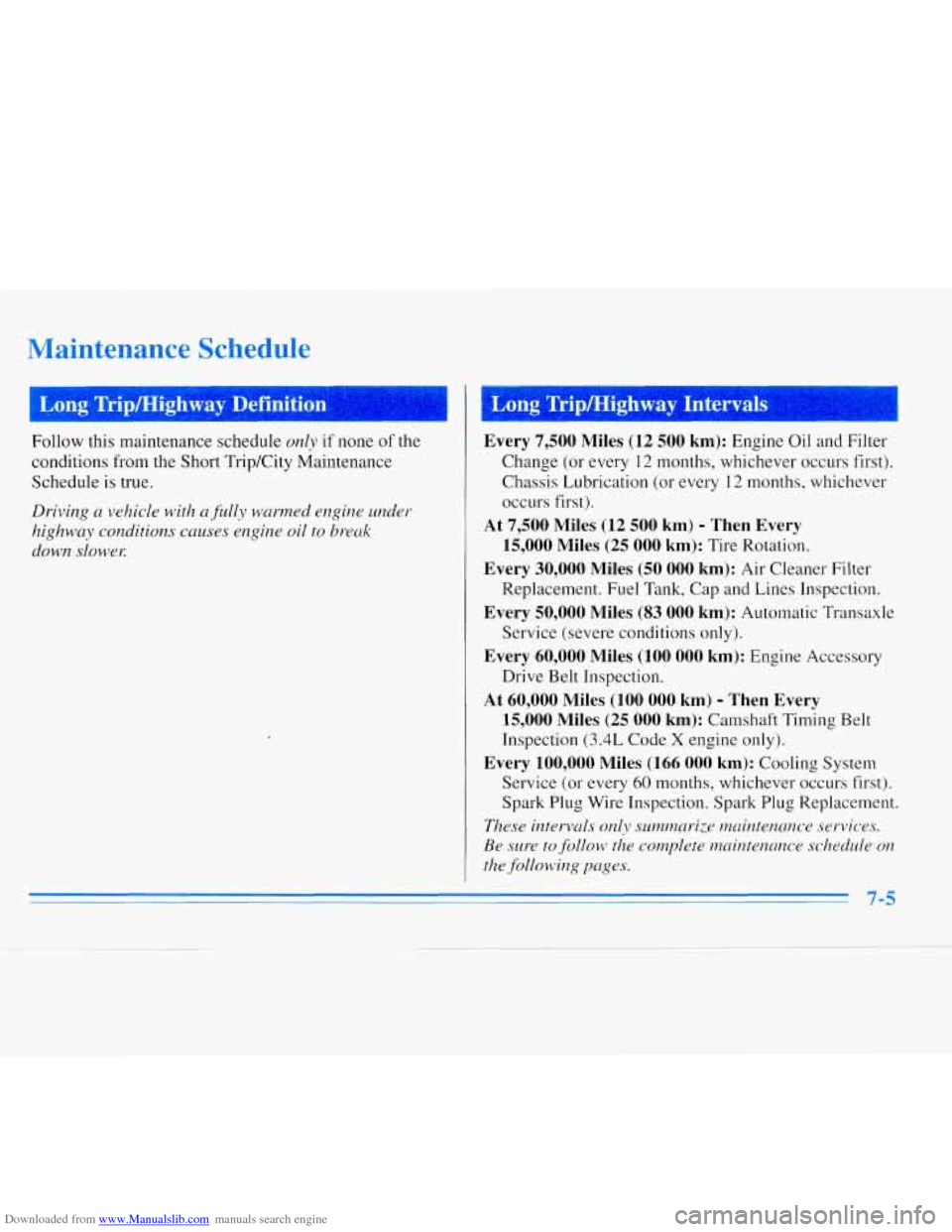
Downloaded from www.Manualslib.com manuals search engine Maintenance Schedule
Follow this maintenance schedule only if none of the
conditions from the Short Trip/City Maintenance
Schedule
is true.
Driving a vehicle with a fully warmed engine under
highway conditions cuuses engine oil to break
down sloweK
Every 7,500 Miles (12 500 km): Engine Oil and Filter
Change (or every
12 months, whichever occurs first).
Chassis Lubrication (or every 12 months, whichever
occurs first).
At 7,500 Miles (12 500 km) - Then Every
15,000 Miles (25
000 km): Tire Rotation.
Every 30,000 Miles (50 000 km): Air Cleaner Filter
Replacement. Fuel Tank, Cap and Lines Inspection.
Every 50,000 Miles (83 000 km): Automatic Transaxle
Service (severe conditions only).
Every 60,000 Miles (100 000 km): Engine Accessory
Drive Belt Inspection.
At 60,000 Miles (100 000 km) - Then Every
15,000 Miles (25 000 km): Camshaft Timing Belt
Inspection
(3.4L Code X engine only).
Every 100,000 Miles (166 000 km): Cooling System
Service (or every
60 months, whichever occurs first).
Spark Plug Wire Inspection. Spark Plug Replacement.
These intervcrls only suwunarize mnintencrnce services.
Be sure to.foIlow the complete maintenance schedule on
the.following pages.
7-5
Page 280 of 340
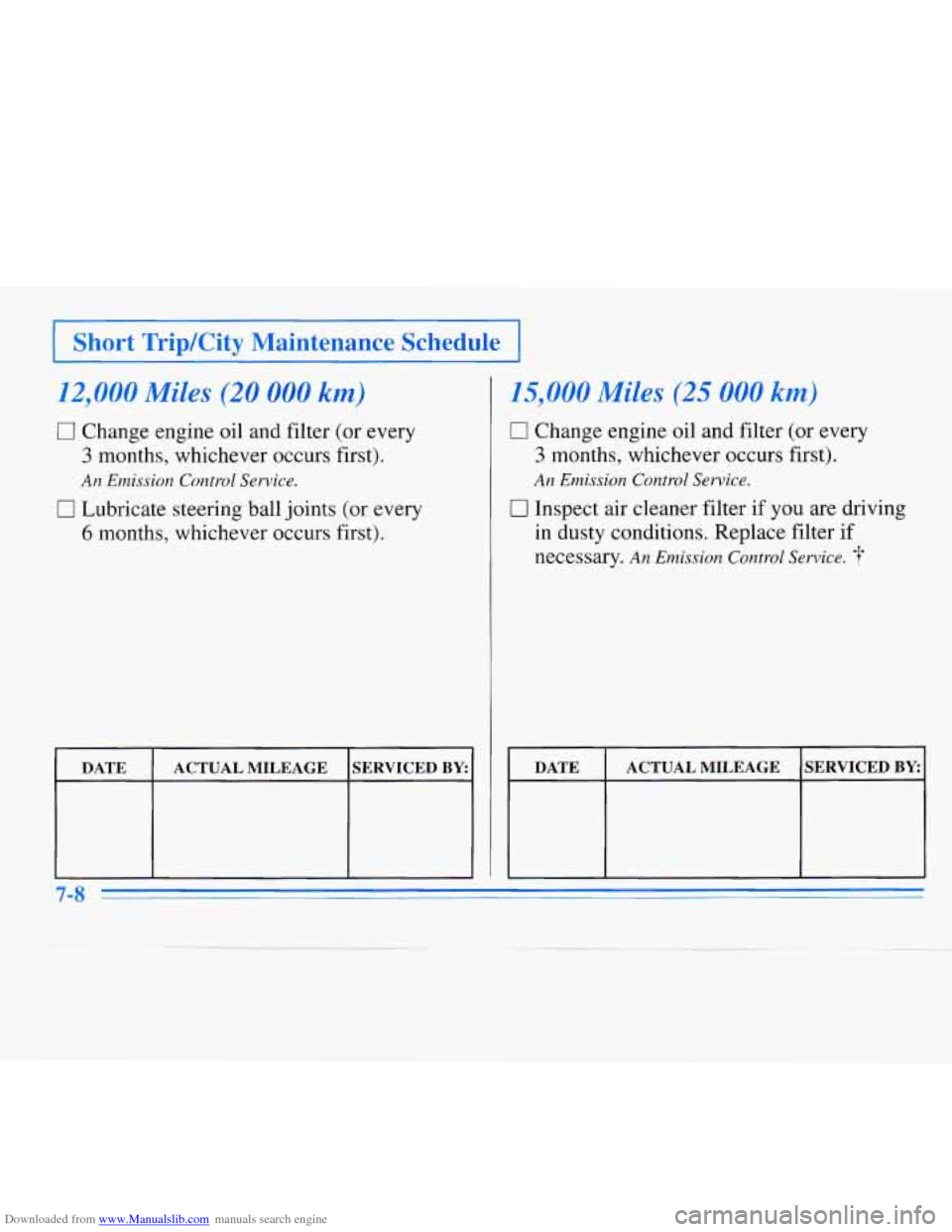
Downloaded from www.Manualslib.com manuals search engine I Short Trip/City Maintenance Schedule I
12,000 Miles (20 000 km)
17 Change engine oil and filter (or every
3 months, whichever occurs first).
An Emission Control Service.
0 Lubricate steering ball joints (or every
6 months, whichever occurs first).
DATE SERVICED BY ACTUAL MILEAGE
lS,OOO Miles (25 000 km)
0 Change engine oil and filter (or every
3 months, whichever occurs first).
An Emission Control Service.
0 Inspect air cleaner filter if you are driving
in dusty conditions. Replace filter if
necessary.
An Emission Control Service.
DATE SERVICED BY: ACTUAL MILEAGE
7-8
Page 286 of 340
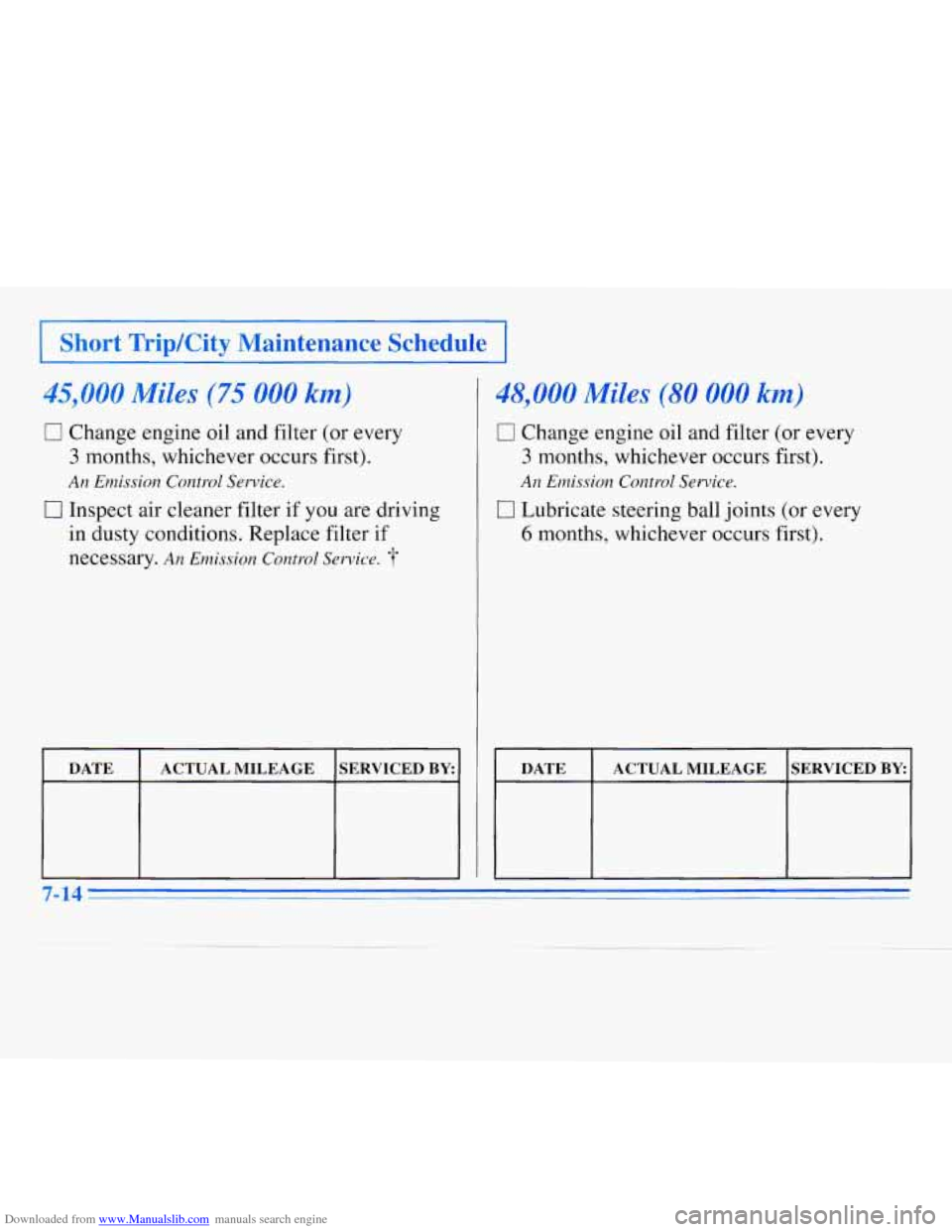
Downloaded from www.Manualslib.com manuals search engine 1 Short Trip/City Maintenance Schedule I
45,000 Miles (75 000 km)
0 Change engine oil and filter (or every
3 months, whichever occurs first).
An Enzissiorz Control Service.
0 Inspect air cleaner filter if you are driving
in dusty conditions. Replace filter if
necessary.
An Emission Control Service.
1 I
DATE ACTUAL MILEAGE SERVICED BY
48,000 Miles (80 000 km)
0 Change engine
oil and filter (or every
3 months, whichever occurs first).
An Emission Control Service.
0 Lubricate steering ball joints (or every
6 months, whichever occurs first).
DATE SERVICED BY ACTUAL MILEAGE
7-14
Page 292 of 340
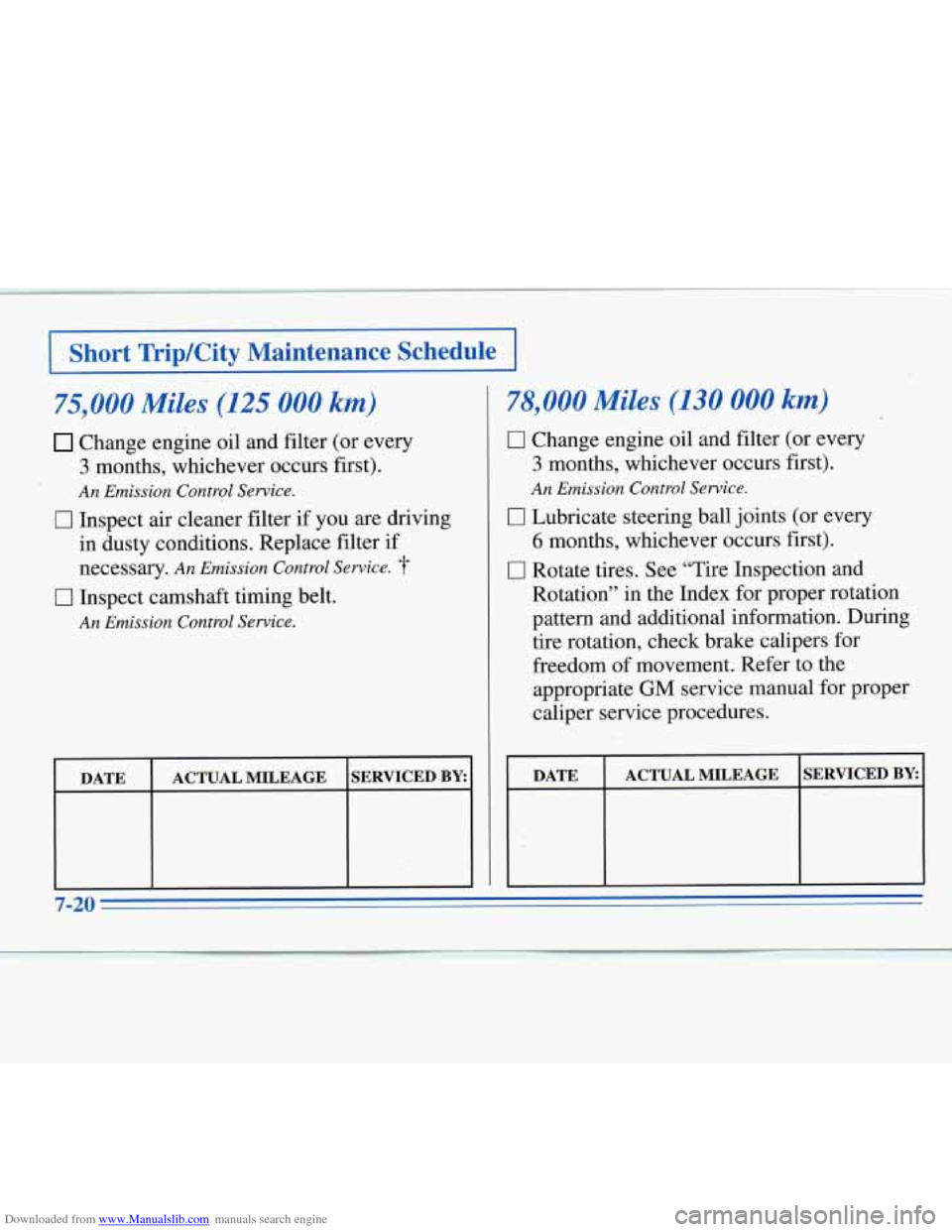
Downloaded from www.Manualslib.com manuals search engine T’ 3 - 1 Short TripKity Maintenance Schedule I
75,000 Miles (125 000 km)
Change engine oil and filter (or every
3 months, whichever occurs first).
An Emission Control Service.
78,000 Miles (130 000 km)
0 Change engine oil and filter (or every
3 months, whichever occurs first).
An Emission Control Service.
0 Inspect air cleaner filter if you are driving 0 Lubricate steering ball joints (or every
in dusty conditions. Replace filter
if 6 months, whichever occurs first).
necessary.
An Emission Control Service. 0 Rotate tires. See “Tire Inspection and
0 Inspect camshaft timing belt. Rotation”
in the Index for proper rotation
An Emission Control Service. pattern and additional information. During
tire rotation, check brake calipers for
freedom of movement. Refer to the
appropriate
GM service manual for proper
caliper service procedures.
-
DATE ACTUAL MILEAGE SERVICED BY: DATE ACTUAL MILEAGE SERVICED BY:
’
7-20
Page 312 of 340

Downloaded from www.Manualslib.com manuals search engine Part C: Periodic Maintenance
Inspections
Listed below are inspections and services which should be
performed at least twice
a year (for instance, each spring
and fall). You should let your
GM dealer’s service
department or other qualified service center do these jobs.
Make sure any necessary repairs are completed at once.
Proper procedures to perform these services may be
found
in a Chevrolet service manual. See “Service and
Owner Publications”
in the Index.
Steering, Suspension and Front-Wheel-Drive
Axle Boot and Seal Inspection
Inspect the front and rear suspension and steering
system for damaged, loose or missing parts, signs of
wear, or lack of lubrication. Inspect the power steering
lines and hoses for proper hookup, binding, leaks,
cracks, chafing, etc. Clean and then inspect the drive
axle boot seals for damage, tears or leakage. Replace
seals if necessary.
Exhaust System Inspection
Inspect the complete exhaust system. Inspect the body
near the exhaust system.
Look for broken, damaged,
missing or out-of-position parts
as well as open seams, holes, loose connections,
or other conditions which
could cause
a heat build-up in the floor pan or could let
exhaust fumes into the vehicle. See “Engine Exhaust’’ in
the Index.
Radiator and Heater Hose Inspection
Inspect the hoses and have them replaced if they are
cracked, swollen or deteriorated. Inspect all pipes,
fittings and clamps; replace
as needed.
Throttle Linkage Inspection
Inspect the throttle linkage for interference or binding,
and for damage or missing parts. Replace parts
as
needed. Replace any cables that have high effort or
excessive wear.
Do not lubricate accelerator and cruise
control cables.
Brake System Inspection
Inspect the complete system. Inspect brake lines and
hoses for proper hookup, binding, leaks, cracks, chafing,
etc. Inspect disc brake pads for wear and rotors for
surface condition. Also inspect drum brake linings for
wear and cracks. Inspect other brake parts, including
drums, wheel cylinders, calipers, parking brake, etc.
Check parking brake adjustment. You may need to have
your brakes inspected more often if your driving habits
or conditions result
in frequent braking.